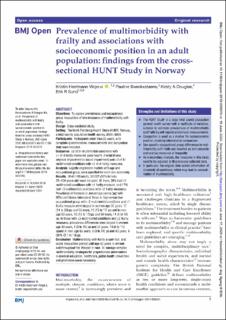Prevalence of multimorbidity with frailty and associations with socioeconomic position in an adult population: findings from the cross-sectional HUNT Study in Norway
Peer reviewed, Journal article
Published version
Permanent lenke
https://hdl.handle.net/11250/2730682Utgivelsesdato
2020Metadata
Vis full innførselSamlinger
Originalversjon
Vinjerui, K. H., Boeckxstaens, P., Douglas, K. A. & Sund, E. R. (2020). Prevalence of multimorbidity with frailty and associations with socioeconomic position in an adult population: findings from the cross-sectional HUNT Study in Norway. BMJ Open, 10(6): e035070. doi: 10.1136/bmjopen-2019-035070Sammendrag
Objectives: To explore prevalences and occupational group inequalities of two measures of multimorbidity with frailty.
Design: Cross-sectional study.
Setting: The Nord-Trøndelag Health Study (HUNT), Norway, a total county population health survey, 2006–2008.
Participants: Participants older than 25 years, with complete questionnaires, measurements and occupation data were included.
Outcomes: ≥2 of 51 multimorbid conditions with ≥1 of 4 frailty measures (poor health, mental illness, physical impairment or social impairment) and ≥3 of 51 multimorbid conditions with ≥2 of 4 frailty measures.
Analysis: Logistic regression models with age and occupational group were specified for each sex separately.
Results: Of 41 193 adults, 38 027 (55% female; 25–100 years old) were included. Of them, 39% had ≥2 multimorbid conditions with ≥1 frailty measure, and 17% had ≥3 multimorbid conditions with ≥2 frailty measures. Prevalence differences in percentage points (pp) with 95% confidence intervals of those in high versus low occupational group with ≥2 multimorbid conditions and ≥1 frailty measure were largest in women age 30 years, 17 (14 to 20) pp and 55 years, 15 (13 to 17) pp and in men age 55 years, 15 (13 to 17) pp and 80 years, 14 (9 to 18) pp. In those with ≥3 multimorbid conditions and ≥2 frailty measures, prevalence differences were largest in women age 30 years, 8 (6 to 10) pp and 55 years, 10 (8 to 11) ppand in men age 55 years, 9 (8 to 11) pp and 80 years, 6 (95% CI 1 to 10) pp.
Conclusion: Multimorbidity with frailty is common, and social inequalities persist until age 80 years in women and throughout the lifespan in men. To manage complex multimorbidity, strategies for proportionate universalism in medical education, healthcare, public health prevention and promotion seem necessary.

